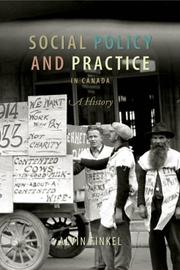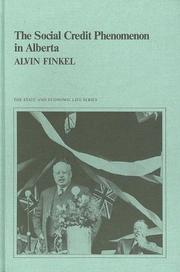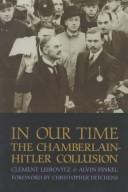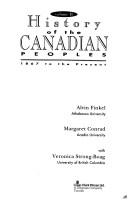| Listing 1 - 9 of 9 |
Sort by
|

ISBN: 1554588863 1280465638 9786610465637 1554580889 1423785568 9781423785569 9780889204751 0889204756 9781280465635 9781554580880 0889204756 Year: 2006 Publisher: Waterloo, Ont. Wilfrid Laurier University Press
Abstract | Keywords | Export | Availability | Bookmark
 Loading...
Loading...Choose an application
- Reference Manager
- EndNote
- RefWorks (Direct export to RefWorks)
Social Policy and Practice in Canada: A History traces the history of social policy in Canada from the period of First Nations’ control to the present day, exploring the various ways in which residents of the area known today as Canada have organized themselves to deal with (or to ignore) the needs of the ill, the poor, the elderly, and the young. This book is the first synthesis on social policy in Canada to provide a critical perspective on the evolution of social policy in the country. While earlier work has treated each new social program as a major advance, and reacted with shock to neoliberalism’s attack on social programs, Alvin Finkel demonstrates that right-wing and left-wing forces have always battled to shape social policy in Canada. He argues that the notion of a welfare state consensus in the period after 1945 is misleading, and that the social programs developed before the neoliberal counteroffensive were far less radical than they are sometimes depicted. Social Policy and Practice in Canada: A History begins by exploring the non-state mechanisms employed by First Nations to insure the well-being of their members. It then deals with the role of the Church in New France and of voluntary organizations in British North America in helping the unfortunate. After examining why voluntary organizations gradually gave way to state-controlled programs, the book assesses the evolution of social policy in Canada in a variety of areas, including health care, treatment of the elderly, child care, housing, and poverty.
État providence --- Aide sociale --- Welfare state --- Public welfare --- State, Welfare --- Economic policy --- Social policy --- State, The --- Welfare economics --- Benevolent institutions --- Poor relief --- Public assistance --- Public charities --- Public relief --- Public welfare reform --- Relief (Aid) --- Social welfare --- Welfare (Public assistance) --- Welfare reform --- Human services --- Social service --- Histoire. --- History. --- Government policy --- Canada --- Politique sociale. --- Social policy.

ISBN: 1282039733 9786612039737 1442682388 9781442682382 9781282039735 0802058213 080206731X 9780802058218 9780802067319 Year: 1989 Publisher: Toronto
Abstract | Keywords | Export | Availability | Bookmark
 Loading...
Loading...Choose an application
- Reference Manager
- EndNote
- RefWorks (Direct export to RefWorks)
Few parties in political history have had such a swift metamorphosis from one end of the political spectrum to the other as did the Social Credit Party of Alberta. Between its establishment in the 1930s and the defeat of the Social Credit government in 1971, the party changed from a movement-based reformist organization to a cliquish, religious-oriented outfit whose main purpose was to hold the levers of power.In this account of the Social Credit transformation, Alvin Finkel challenges earlier works which focus purely on Social Credit monetary fixations and religiosity. He argues that the early party is best seen as a coalition of reformers, including working-class social democrats, the unemployed, small business owners, and farmers placed in jeopardy by the Depression. In its first term of office, Social Credit was perceived as on the left, opposed in the 1940 provincial election by a right-wing coalition.During the later Aberhart years, and especially after Ernest Manning's accession to the premiership, Social Credit switched its fire from bankers to socialists and the party's rhetoric became extremely right-wing. Manning opposed, on ideological grounds, most of the social programs introduced by federal government after 1945.Though patronage was rife, most Albertans regarded Social Credit as righteous because of the leadership of Manning, a radio evangelist. Only Manning's departure from the political scene began the slow process of decay of the governing party.
Political parties --- Parties, Political --- Party systems, Political --- Political party systems --- Political science --- Divided government --- Intra-party disagreements (Political parties) --- Political conventions --- Alberta Social Credit League --- Alberta Social Credit Party --- Social Credit Party (Alta.) --- Social Credit League (Alta.) --- History. --- Alberta. --- Alberta --- Politique et gouvernement --- Politics and government --- Government of Alberta
Book
ISBN: 9781926836591 1926836596 1926836588 9786613533326 1280129441 9781926836607 192683660X 9781926836584 Year: 2012 Publisher: Edmonton, [Alberta] : AU Press,
Abstract | Keywords | Export | Availability | Bookmark
 Loading...
Loading...Choose an application
- Reference Manager
- EndNote
- RefWorks (Direct export to RefWorks)
A political and economic analysis of the history of working people in Alberta.
Labor --- Working class --- Commons (Social order) --- Labor and laboring classes --- Laboring class --- Labouring class --- Working classes --- Social classes --- Manpower --- Work --- History --- Employment --- Alberta --- Government of Alberta --- Economic conditions. --- Economic policy. --- E-books --- History.

ISBN: 0853459991 Year: 1998 Publisher: New York Monthly Review Press
Abstract | Keywords | Export | Availability | Bookmark
 Loading...
Loading...Choose an application
- Reference Manager
- EndNote
- RefWorks (Direct export to RefWorks)

ISBN: 077304843X 0773051899 0773053468 Year: 1993 Publisher: Toronto : Copp Clark Pitman,
Abstract | Keywords | Export | Availability | Bookmark
Book
ISBN: 9781897425817 1897425813 1282852035 9781282852037 9781897425800 1897425805 9786612852039 Year: 2010 Publisher: Edmonton Athabasca University
Abstract | Keywords | Export | Availability | Bookmark
 Loading...
Loading...Choose an application
- Reference Manager
- EndNote
- RefWorks (Direct export to RefWorks)
The West and Beyond explores the state of Western Canadian history, showcasing the research interests of a new generation of scholars while charting new directions for the future and stimulating further interrogation of our past. This dynamic collection encourages dialogue among generations of historians of the West, and among practitioners of diverse approaches to the past. It also reflects a broad range of disciplinary and professional boundaries, offering new ways to understand the West.
Working class --- Marginality, Social --- History --- Canada, Western --- Exclusion, Social --- Marginal peoples --- Social exclusion --- Social marginality --- Assimilation (Sociology) --- Culture conflict --- Social isolation --- Sociology --- People with social disabilities --- Commons (Social order) --- Labor and laboring classes --- Laboring class --- Labouring class --- Working classes --- Social classes --- Labor --- Employment --- Canadian Northwest --- West (Canada) --- Western Canada --- Northwest, Canadian --- Canadian history --- First Nations
Book
Year: 2012 Publisher: Edmonton : Athabasca University Press,
Abstract | Keywords | Export | Availability | Bookmark
 Loading...
Loading...Choose an application
- Reference Manager
- EndNote
- RefWorks (Direct export to RefWorks)
Working People in Alberta traces the history of labour in Alberta from the period of First Nations occupation to the present. Drawing on over two hundred interviews with labour leaders, activists, and ordinary working people, as well as on archival records, the volume gives voice to the people who have toiled in Alberta over the centuries. In so doing, it seeks to counter the view of Alberta as a one-class, one-party, one-ideology province, in which distinctions between those who work and those who own are irrelevant. Workers from across the generations tell another tale, of an ongoing collective struggle to improve their economic and social circumstances in the face of a dominant, exploitative elite. Their stories are set within a sequential analysis of provincial politics and economics, supplemented by chapters on women and the labour movement and on minority workers of colour and their quest for social justice. Published on the occasion of the 100th anniversary of the Alberta Federation of Labour, Working People in Alberta contrasts the stories of workers who were union members and those who were not. In its depictions of union organizing drives, strikes, and working-class life in cities and towns, this lavishly illustrated volume creates a composite portrait of the men and women who have worked to build and sustain the province of Alberta.
Book
Year: 2012 Publisher: Edmonton : Athabasca University Press,
Abstract | Keywords | Export | Availability | Bookmark
 Loading...
Loading...Choose an application
- Reference Manager
- EndNote
- RefWorks (Direct export to RefWorks)
Working People in Alberta traces the history of labour in Alberta from the period of First Nations occupation to the present. Drawing on over two hundred interviews with labour leaders, activists, and ordinary working people, as well as on archival records, the volume gives voice to the people who have toiled in Alberta over the centuries. In so doing, it seeks to counter the view of Alberta as a one-class, one-party, one-ideology province, in which distinctions between those who work and those who own are irrelevant. Workers from across the generations tell another tale, of an ongoing collective struggle to improve their economic and social circumstances in the face of a dominant, exploitative elite. Their stories are set within a sequential analysis of provincial politics and economics, supplemented by chapters on women and the labour movement and on minority workers of colour and their quest for social justice. Published on the occasion of the 100th anniversary of the Alberta Federation of Labour, Working People in Alberta contrasts the stories of workers who were union members and those who were not. In its depictions of union organizing drives, strikes, and working-class life in cities and towns, this lavishly illustrated volume creates a composite portrait of the men and women who have worked to build and sustain the province of Alberta.
Book
Year: 2012 Publisher: Edmonton : Athabasca University Press,
Abstract | Keywords | Export | Availability | Bookmark
 Loading...
Loading...Choose an application
- Reference Manager
- EndNote
- RefWorks (Direct export to RefWorks)
Working People in Alberta traces the history of labour in Alberta from the period of First Nations occupation to the present. Drawing on over two hundred interviews with labour leaders, activists, and ordinary working people, as well as on archival records, the volume gives voice to the people who have toiled in Alberta over the centuries. In so doing, it seeks to counter the view of Alberta as a one-class, one-party, one-ideology province, in which distinctions between those who work and those who own are irrelevant. Workers from across the generations tell another tale, of an ongoing collective struggle to improve their economic and social circumstances in the face of a dominant, exploitative elite. Their stories are set within a sequential analysis of provincial politics and economics, supplemented by chapters on women and the labour movement and on minority workers of colour and their quest for social justice. Published on the occasion of the 100th anniversary of the Alberta Federation of Labour, Working People in Alberta contrasts the stories of workers who were union members and those who were not. In its depictions of union organizing drives, strikes, and working-class life in cities and towns, this lavishly illustrated volume creates a composite portrait of the men and women who have worked to build and sustain the province of Alberta.
| Listing 1 - 9 of 9 |
Sort by
|

 Search
Search Feedback
Feedback About UniCat
About UniCat  Help
Help News
News